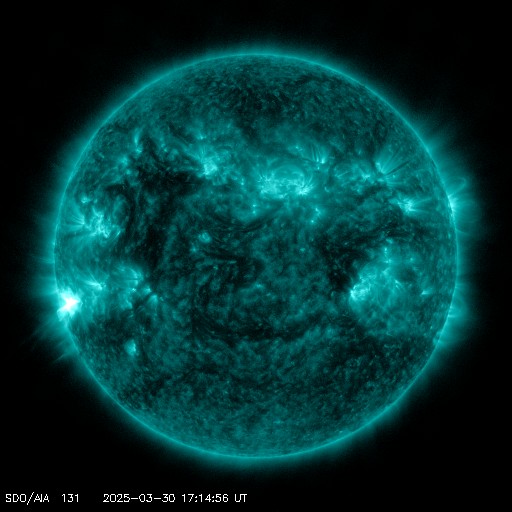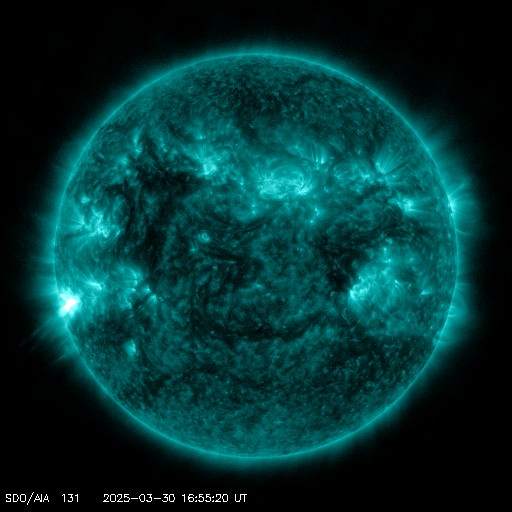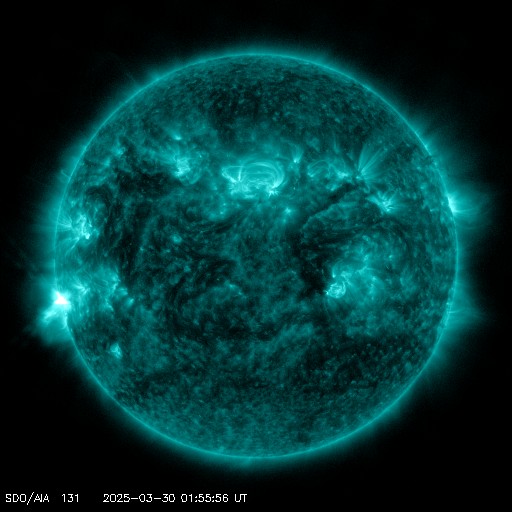Viewing archive of Thursday, 23 May 2002
Solar activity report
Any mentioned solar flare in this report has a scaling factor applied by the Space Weather Prediction Center (SWPC). Because of the SWPC scaling factor, solar flares are reported as 42% smaller than for the science quality data. The scaling factor has been removed from our archived solar flare data to reflect the true physical units.
Report of Solar-Geophysical Activity 2002 May 23 2200 UTCPrepared by the NOAA © SWPC and processed by SpaceWeatherLive.com
Joint USAF/NOAA Report of Solar and Geophysical Activity
SDF Number 143 Issued at 2200Z on 23 May 2002IA. Analysis of Solar Active Regions and Activity from 22-2100Z to 23-2100Z
Solar activity was low. Region 9961 (S22E22) grew
slowly as it produced a few minor C-class flares. The delta
configuration is now apparent in the center of the group, as the
leading spot simplified. Region 9957 (N10W19) decayed slightly but
still retains a modest degree of magnetic complexity. Two new
regions, 9966 (N10E34) and 9967 (N13E46) emerged.
IB. Solar Activity Forecast
Solar activity is expected to be
moderate. Regions 9957 and 9961 are the most likely sites for
isolated M-class flares. There continues to be a slight chance for a
major flare event.
IIA. Geophysical Activity Summary 22-2100Z to 23-2100Z
The geomagnetic field varied from quiet to severe storm levels. The
first of two shocks detected today passed ACE around 1000 UTC, as
solar wind speeds increased from 400 to 600 km/s, causing a sudden
impulse of 87 nT to be registered at Boulder at 1051 UTC. At
approximately 1500 UTC, a second shock, boosting solar wind speeds
to near 1,000 km/s for a short period, was seen at ACE. This
perturbation caused a 26 nT sudden impulse at Boulder at 1545 UTC.
This activity is thought to be an effect of the multiple CMEs
observed to leave the sun yesterday. The greater than 10 MeV proton
event that began at 22/1755 UTC attained a tentative maximum of 820
pfu at 23/1055 UTC and continues in progress.
IIB. Geophysical Activity Forecast
The geomagnetic field is
expected to be at active to minor storm levels for the next 24 hours
as the current disturbance wanes. No additional shocks or CMEs are
expected. The field should continue to calm to unsettled conditions
by the end of the interval. The greater than 10 MeV proton fluxes
should continue to slowly decline.
III. Event Probabilities 24 May to 26 May
| Class M | 50% | 50% | 50% |
| Class X | 10% | 10% | 10% |
| Proton | 35% | 10% | 10% |
| PCAF | yellow | ||
IV. Penticton 10.7 cm Flux
Observed 23 May 180 Predicted 24 May-26 May 175/170/170 90 Day Mean 23 May 184
V. Geomagnetic A Indices
Observed Afr/Ap 22 May 010/014 Estimated Afr/Ap 23 May 045/050 Predicted Afr/Ap 24 May-26 May 025/030-015/015-010/010
VI. Geomagnetic Activity Probabilities 24 May to 26 May
| A. Middle Latitudes | |||
|---|---|---|---|
| Active | 45% | 40% | 30% |
| Minor storm | 25% | 20% | 15% |
| Major-severe storm | 25% | 10% | 05% |
| B. High Latitudes | |||
|---|---|---|---|
| Active | 15% | 25% | 30% |
| Minor storm | 25% | 30% | 20% |
| Major-severe storm | 40% | 20% | 15% |
All times in UTC
Current data suggests there is a slight possibility for aurora to appear at the following high latitude regions in the near future
Rovaniemi, Sodankylä, UtsjokiKirkenes, Tromsø
Murmansk
Kiruna
Latest news
Latest forum messages
More topicsSupport SpaceWeatherLive.com!
A lot of people come to SpaceWeatherLive to follow the Sun's activity or if there is aurora to be seen, but with more traffic comes higher server costs. Consider a donation if you enjoy SpaceWeatherLive so we can keep the website online!

Latest alerts
17:27 UTC - Solar flare
Moderate M1.5 flare
17:03 UTC - Solar flare
Moderate M1.61 flare
16:45 UTC - Radio Blackout
Minor R1 radio blackout in progress (≥M1 - current: M1.61)
02:09 UTC - Solar flare
Moderate M1.54 flare from sunspot region 4048
01:42 UTC - Radio Blackout
Minor R1 radio blackout in progress (≥M1 - current: M1.24)
Space weather facts
| Last X-flare | 2025/03/28 | X1.1 |
| Last M-flare | 2025/03/30 | M1.4 |
| Last geomagnetic storm | 2025/03/27 | Kp5 (G1) |
| Spotless days | |
|---|---|
| Last spotless day | 2022/06/08 |
| Monthly mean Sunspot Number | |
|---|---|
| February 2025 | 154.6 +17.6 |
| March 2025 | 127.5 -27.1 |
| Last 30 days | 127.5 -24.7 |





